Exploring Critical Issues in Adult Care: Legal and Ethical Aspects
VerifiedAdded on 2023/01/13
|11
|3268
|87
Essay
AI Summary
This essay delves into critical issues in adult care, focusing on legal and ethical considerations, safeguarding concerns, and the application of theoretical perspectives. The analysis centers on a case study involving an elderly woman, Margaret, and her son, Paul, who has a learning disability, depression, and anxiety. The essay examines institutional abuse and poor standards of care, highlighting the importance of patient-centered care in improving health outcomes. It also explores the use of cognitive behavioral therapy (CBT) to address Paul's emotional and behavioral issues, including his aggression and sleep disturbances. The essay emphasizes the need for healthcare practitioners to provide compassionate, respectful, and tailored care, while also addressing the sociological influences on individual health and the importance of creating a safe and supportive environment for patients. The essay also examines the role of family and friends in the patient's care and recovery.
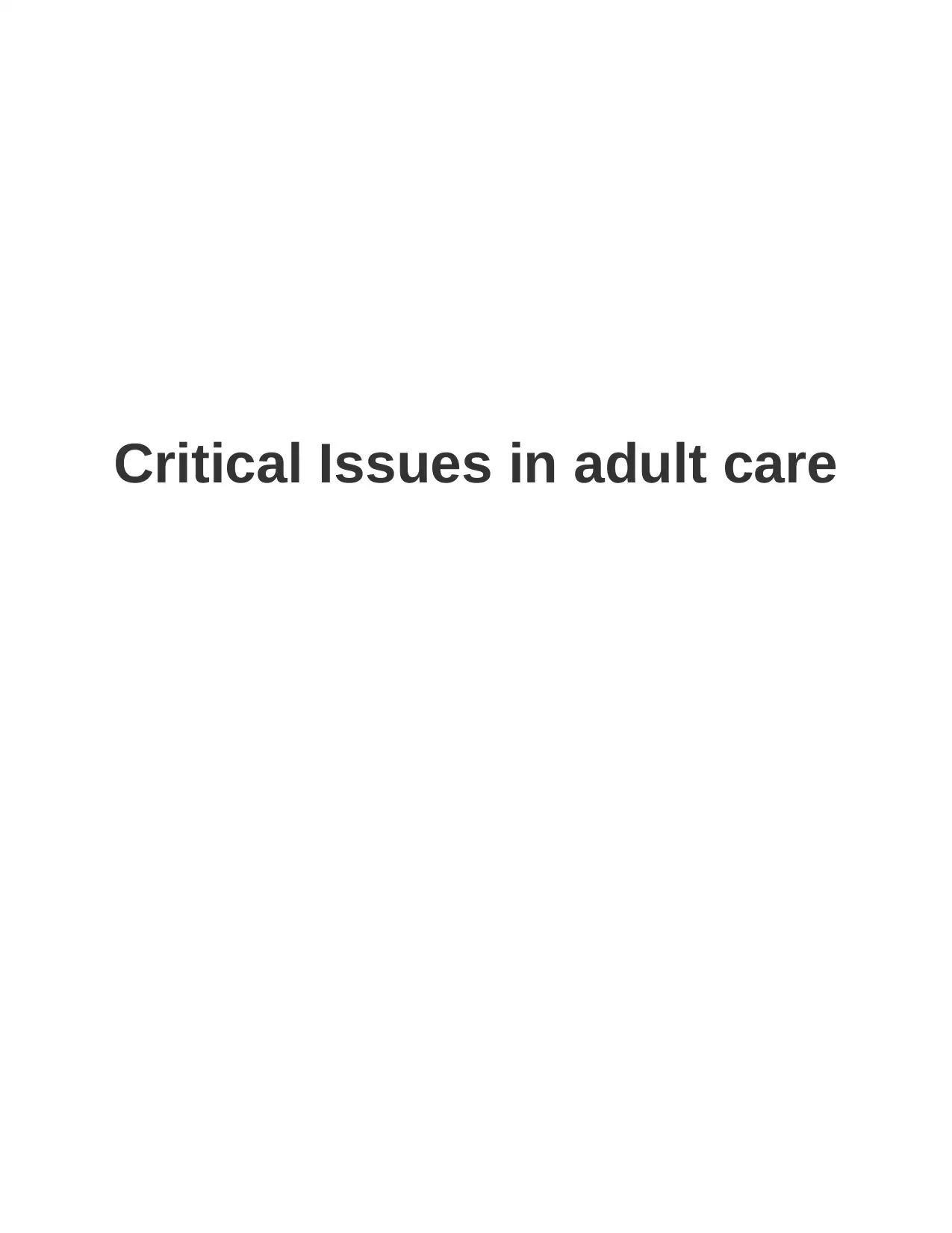
Critical Issues in adult care
Paraphrase This Document
Need a fresh take? Get an instant paraphrase of this document with our AI Paraphraser
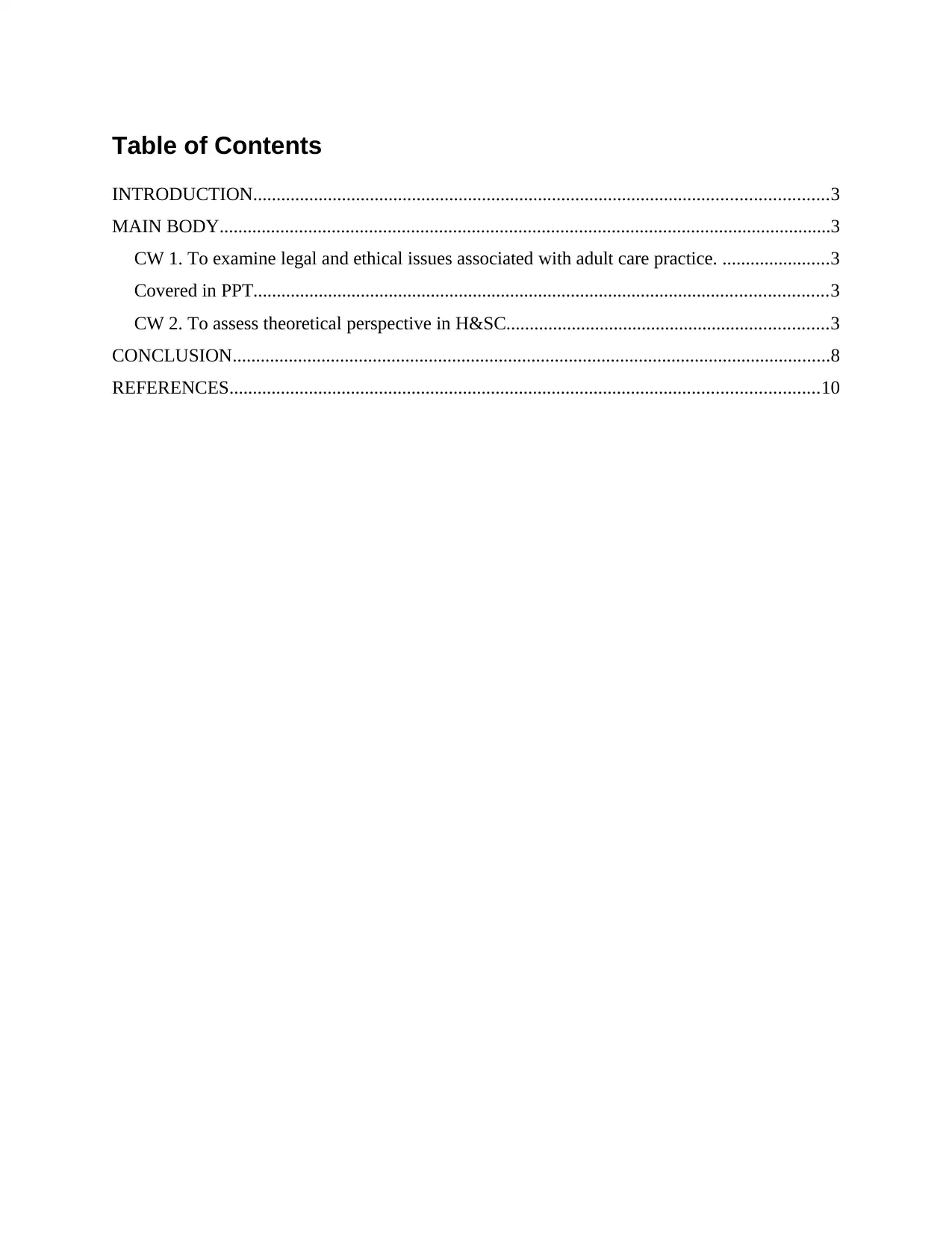
Table of Contents
INTRODUCTION...........................................................................................................................3
MAIN BODY...................................................................................................................................3
CW 1. To examine legal and ethical issues associated with adult care practice. .......................3
Covered in PPT...........................................................................................................................3
CW 2. To assess theoretical perspective in H&SC.....................................................................3
CONCLUSION................................................................................................................................8
REFERENCES..............................................................................................................................10
INTRODUCTION...........................................................................................................................3
MAIN BODY...................................................................................................................................3
CW 1. To examine legal and ethical issues associated with adult care practice. .......................3
Covered in PPT...........................................................................................................................3
CW 2. To assess theoretical perspective in H&SC.....................................................................3
CONCLUSION................................................................................................................................8
REFERENCES..............................................................................................................................10
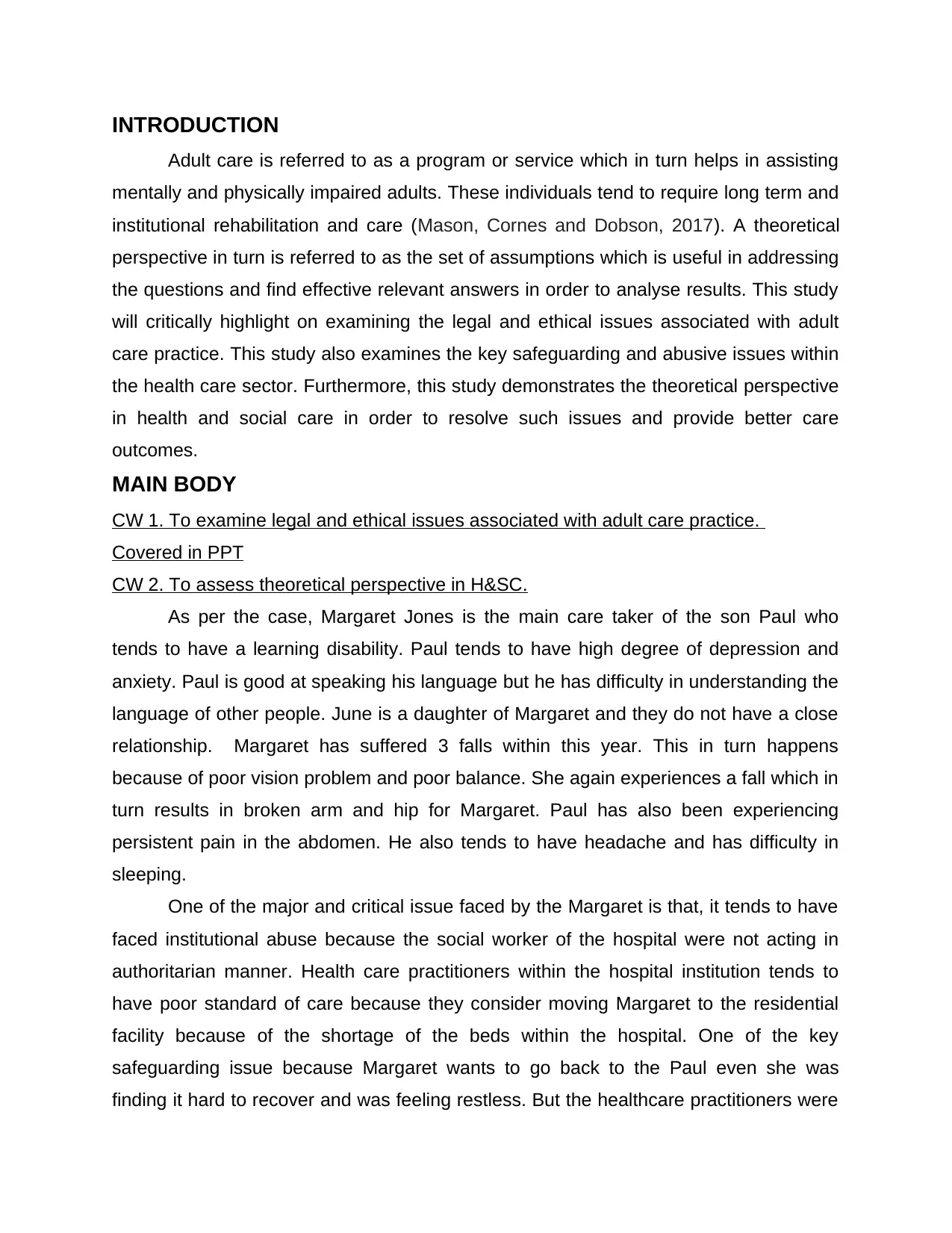
INTRODUCTION
Adult care is referred to as a program or service which in turn helps in assisting
mentally and physically impaired adults. These individuals tend to require long term and
institutional rehabilitation and care (Mason, Cornes and Dobson, 2017). A theoretical
perspective in turn is referred to as the set of assumptions which is useful in addressing
the questions and find effective relevant answers in order to analyse results. This study
will critically highlight on examining the legal and ethical issues associated with adult
care practice. This study also examines the key safeguarding and abusive issues within
the health care sector. Furthermore, this study demonstrates the theoretical perspective
in health and social care in order to resolve such issues and provide better care
outcomes.
MAIN BODY
CW 1. To examine legal and ethical issues associated with adult care practice.
Covered in PPT
CW 2. To assess theoretical perspective in H&SC.
As per the case, Margaret Jones is the main care taker of the son Paul who
tends to have a learning disability. Paul tends to have high degree of depression and
anxiety. Paul is good at speaking his language but he has difficulty in understanding the
language of other people. June is a daughter of Margaret and they do not have a close
relationship. Margaret has suffered 3 falls within this year. This in turn happens
because of poor vision problem and poor balance. She again experiences a fall which in
turn results in broken arm and hip for Margaret. Paul has also been experiencing
persistent pain in the abdomen. He also tends to have headache and has difficulty in
sleeping.
One of the major and critical issue faced by the Margaret is that, it tends to have
faced institutional abuse because the social worker of the hospital were not acting in
authoritarian manner. Health care practitioners within the hospital institution tends to
have poor standard of care because they consider moving Margaret to the residential
facility because of the shortage of the beds within the hospital. One of the key
safeguarding issue because Margaret wants to go back to the Paul even she was
finding it hard to recover and was feeling restless. But the healthcare practitioners were
Adult care is referred to as a program or service which in turn helps in assisting
mentally and physically impaired adults. These individuals tend to require long term and
institutional rehabilitation and care (Mason, Cornes and Dobson, 2017). A theoretical
perspective in turn is referred to as the set of assumptions which is useful in addressing
the questions and find effective relevant answers in order to analyse results. This study
will critically highlight on examining the legal and ethical issues associated with adult
care practice. This study also examines the key safeguarding and abusive issues within
the health care sector. Furthermore, this study demonstrates the theoretical perspective
in health and social care in order to resolve such issues and provide better care
outcomes.
MAIN BODY
CW 1. To examine legal and ethical issues associated with adult care practice.
Covered in PPT
CW 2. To assess theoretical perspective in H&SC.
As per the case, Margaret Jones is the main care taker of the son Paul who
tends to have a learning disability. Paul tends to have high degree of depression and
anxiety. Paul is good at speaking his language but he has difficulty in understanding the
language of other people. June is a daughter of Margaret and they do not have a close
relationship. Margaret has suffered 3 falls within this year. This in turn happens
because of poor vision problem and poor balance. She again experiences a fall which in
turn results in broken arm and hip for Margaret. Paul has also been experiencing
persistent pain in the abdomen. He also tends to have headache and has difficulty in
sleeping.
One of the major and critical issue faced by the Margaret is that, it tends to have
faced institutional abuse because the social worker of the hospital were not acting in
authoritarian manner. Health care practitioners within the hospital institution tends to
have poor standard of care because they consider moving Margaret to the residential
facility because of the shortage of the beds within the hospital. One of the key
safeguarding issue because Margaret wants to go back to the Paul even she was
finding it hard to recover and was feeling restless. But the healthcare practitioners were
⊘ This is a preview!⊘
Do you want full access?
Subscribe today to unlock all pages.

Trusted by 1+ million students worldwide
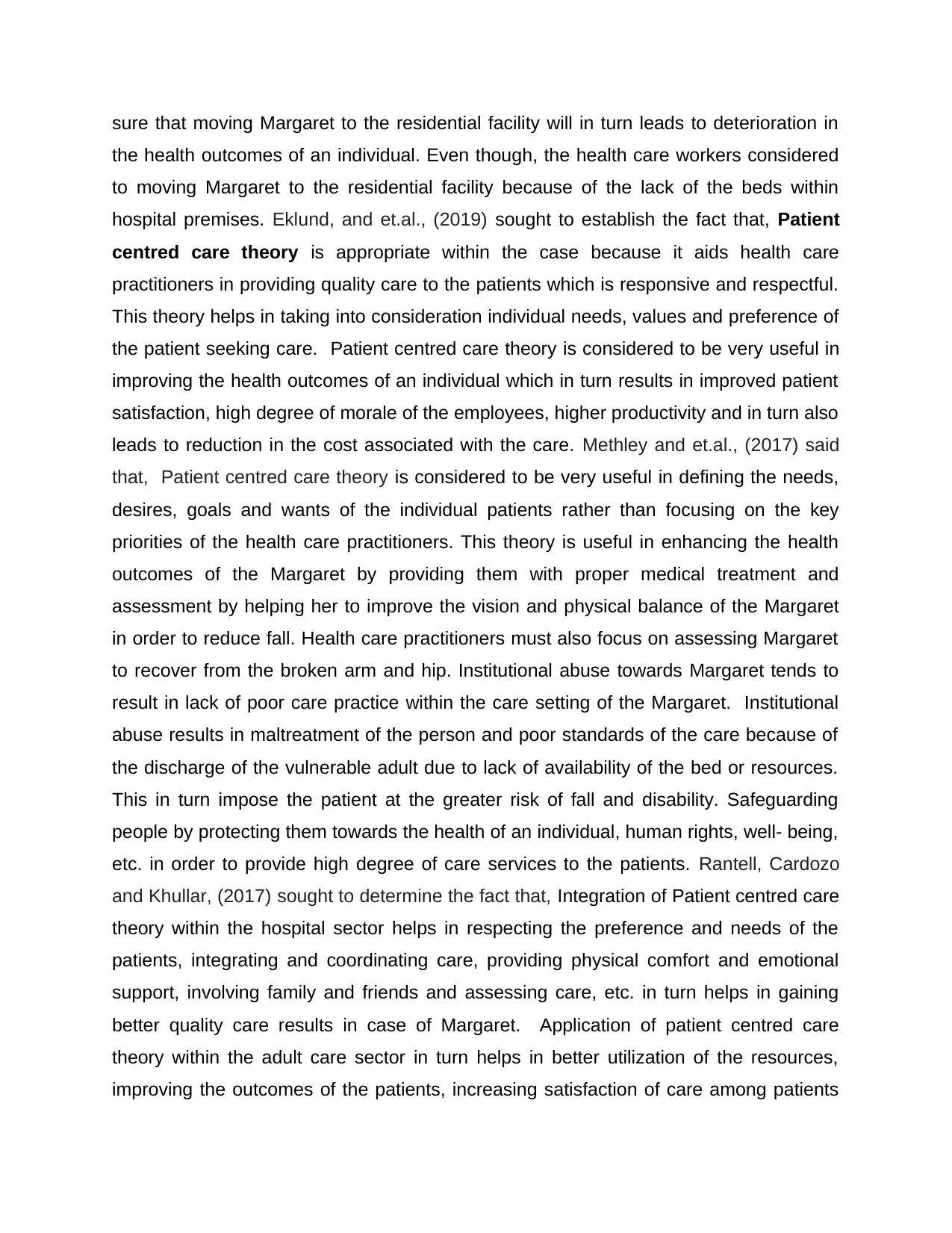
sure that moving Margaret to the residential facility will in turn leads to deterioration in
the health outcomes of an individual. Even though, the health care workers considered
to moving Margaret to the residential facility because of the lack of the beds within
hospital premises. Eklund, and et.al., (2019) sought to establish the fact that, Patient
centred care theory is appropriate within the case because it aids health care
practitioners in providing quality care to the patients which is responsive and respectful.
This theory helps in taking into consideration individual needs, values and preference of
the patient seeking care. Patient centred care theory is considered to be very useful in
improving the health outcomes of an individual which in turn results in improved patient
satisfaction, high degree of morale of the employees, higher productivity and in turn also
leads to reduction in the cost associated with the care. Methley and et.al., (2017) said
that, Patient centred care theory is considered to be very useful in defining the needs,
desires, goals and wants of the individual patients rather than focusing on the key
priorities of the health care practitioners. This theory is useful in enhancing the health
outcomes of the Margaret by providing them with proper medical treatment and
assessment by helping her to improve the vision and physical balance of the Margaret
in order to reduce fall. Health care practitioners must also focus on assessing Margaret
to recover from the broken arm and hip. Institutional abuse towards Margaret tends to
result in lack of poor care practice within the care setting of the Margaret. Institutional
abuse results in maltreatment of the person and poor standards of the care because of
the discharge of the vulnerable adult due to lack of availability of the bed or resources.
This in turn impose the patient at the greater risk of fall and disability. Safeguarding
people by protecting them towards the health of an individual, human rights, well- being,
etc. in order to provide high degree of care services to the patients. Rantell, Cardozo
and Khullar, (2017) sought to determine the fact that, Integration of Patient centred care
theory within the hospital sector helps in respecting the preference and needs of the
patients, integrating and coordinating care, providing physical comfort and emotional
support, involving family and friends and assessing care, etc. in turn helps in gaining
better quality care results in case of Margaret. Application of patient centred care
theory within the adult care sector in turn helps in better utilization of the resources,
improving the outcomes of the patients, increasing satisfaction of care among patients
the health outcomes of an individual. Even though, the health care workers considered
to moving Margaret to the residential facility because of the lack of the beds within
hospital premises. Eklund, and et.al., (2019) sought to establish the fact that, Patient
centred care theory is appropriate within the case because it aids health care
practitioners in providing quality care to the patients which is responsive and respectful.
This theory helps in taking into consideration individual needs, values and preference of
the patient seeking care. Patient centred care theory is considered to be very useful in
improving the health outcomes of an individual which in turn results in improved patient
satisfaction, high degree of morale of the employees, higher productivity and in turn also
leads to reduction in the cost associated with the care. Methley and et.al., (2017) said
that, Patient centred care theory is considered to be very useful in defining the needs,
desires, goals and wants of the individual patients rather than focusing on the key
priorities of the health care practitioners. This theory is useful in enhancing the health
outcomes of the Margaret by providing them with proper medical treatment and
assessment by helping her to improve the vision and physical balance of the Margaret
in order to reduce fall. Health care practitioners must also focus on assessing Margaret
to recover from the broken arm and hip. Institutional abuse towards Margaret tends to
result in lack of poor care practice within the care setting of the Margaret. Institutional
abuse results in maltreatment of the person and poor standards of the care because of
the discharge of the vulnerable adult due to lack of availability of the bed or resources.
This in turn impose the patient at the greater risk of fall and disability. Safeguarding
people by protecting them towards the health of an individual, human rights, well- being,
etc. in order to provide high degree of care services to the patients. Rantell, Cardozo
and Khullar, (2017) sought to determine the fact that, Integration of Patient centred care
theory within the hospital sector helps in respecting the preference and needs of the
patients, integrating and coordinating care, providing physical comfort and emotional
support, involving family and friends and assessing care, etc. in turn helps in gaining
better quality care results in case of Margaret. Application of patient centred care
theory within the adult care sector in turn helps in better utilization of the resources,
improving the outcomes of the patients, increasing satisfaction of care among patients
Paraphrase This Document
Need a fresh take? Get an instant paraphrase of this document with our AI Paraphraser
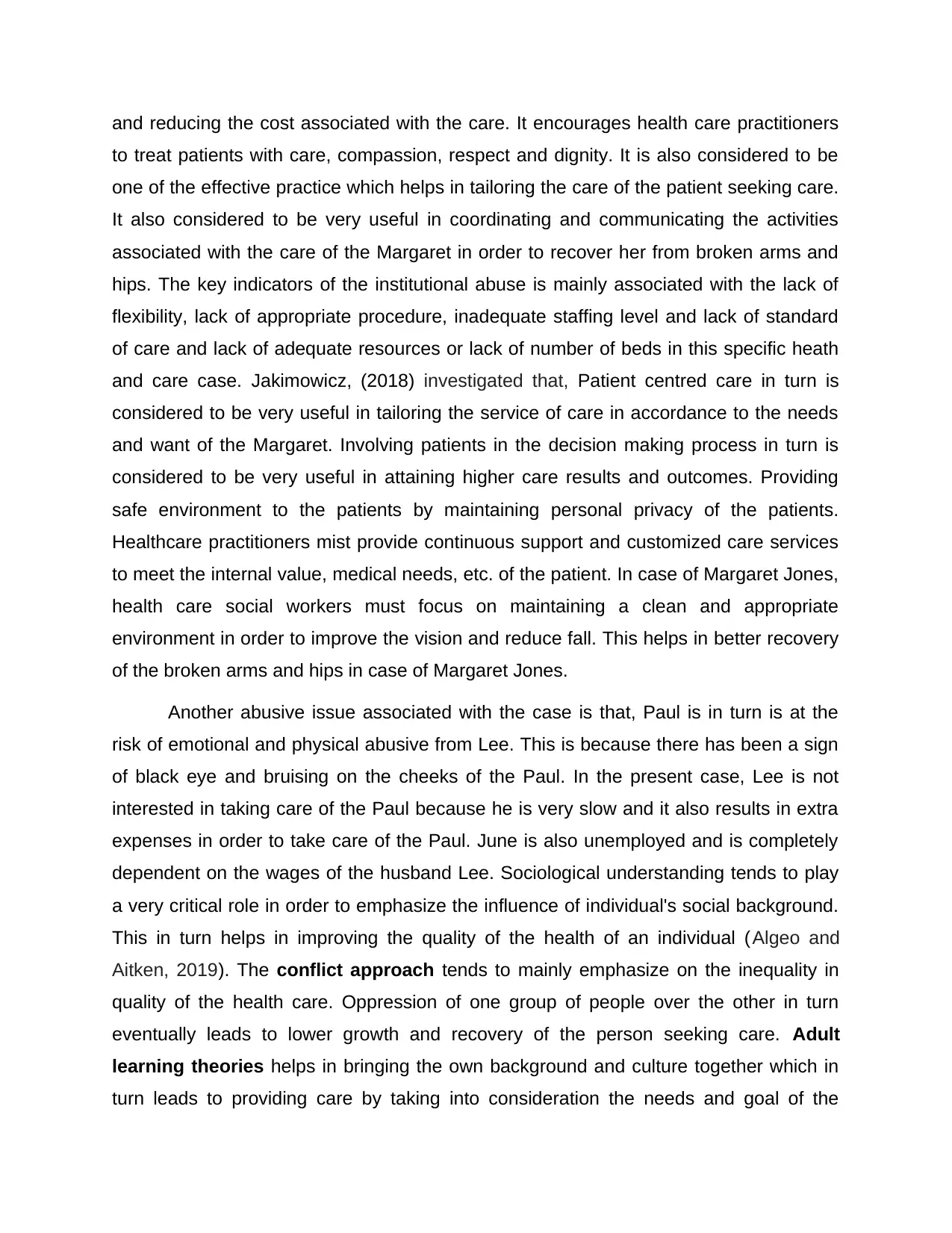
and reducing the cost associated with the care. It encourages health care practitioners
to treat patients with care, compassion, respect and dignity. It is also considered to be
one of the effective practice which helps in tailoring the care of the patient seeking care.
It also considered to be very useful in coordinating and communicating the activities
associated with the care of the Margaret in order to recover her from broken arms and
hips. The key indicators of the institutional abuse is mainly associated with the lack of
flexibility, lack of appropriate procedure, inadequate staffing level and lack of standard
of care and lack of adequate resources or lack of number of beds in this specific heath
and care case. Jakimowicz, (2018) investigated that, Patient centred care in turn is
considered to be very useful in tailoring the service of care in accordance to the needs
and want of the Margaret. Involving patients in the decision making process in turn is
considered to be very useful in attaining higher care results and outcomes. Providing
safe environment to the patients by maintaining personal privacy of the patients.
Healthcare practitioners mist provide continuous support and customized care services
to meet the internal value, medical needs, etc. of the patient. In case of Margaret Jones,
health care social workers must focus on maintaining a clean and appropriate
environment in order to improve the vision and reduce fall. This helps in better recovery
of the broken arms and hips in case of Margaret Jones.
Another abusive issue associated with the case is that, Paul is in turn is at the
risk of emotional and physical abusive from Lee. This is because there has been a sign
of black eye and bruising on the cheeks of the Paul. In the present case, Lee is not
interested in taking care of the Paul because he is very slow and it also results in extra
expenses in order to take care of the Paul. June is also unemployed and is completely
dependent on the wages of the husband Lee. Sociological understanding tends to play
a very critical role in order to emphasize the influence of individual's social background.
This in turn helps in improving the quality of the health of an individual (Algeo and
Aitken, 2019). The conflict approach tends to mainly emphasize on the inequality in
quality of the health care. Oppression of one group of people over the other in turn
eventually leads to lower growth and recovery of the person seeking care. Adult
learning theories helps in bringing the own background and culture together which in
turn leads to providing care by taking into consideration the needs and goal of the
to treat patients with care, compassion, respect and dignity. It is also considered to be
one of the effective practice which helps in tailoring the care of the patient seeking care.
It also considered to be very useful in coordinating and communicating the activities
associated with the care of the Margaret in order to recover her from broken arms and
hips. The key indicators of the institutional abuse is mainly associated with the lack of
flexibility, lack of appropriate procedure, inadequate staffing level and lack of standard
of care and lack of adequate resources or lack of number of beds in this specific heath
and care case. Jakimowicz, (2018) investigated that, Patient centred care in turn is
considered to be very useful in tailoring the service of care in accordance to the needs
and want of the Margaret. Involving patients in the decision making process in turn is
considered to be very useful in attaining higher care results and outcomes. Providing
safe environment to the patients by maintaining personal privacy of the patients.
Healthcare practitioners mist provide continuous support and customized care services
to meet the internal value, medical needs, etc. of the patient. In case of Margaret Jones,
health care social workers must focus on maintaining a clean and appropriate
environment in order to improve the vision and reduce fall. This helps in better recovery
of the broken arms and hips in case of Margaret Jones.
Another abusive issue associated with the case is that, Paul is in turn is at the
risk of emotional and physical abusive from Lee. This is because there has been a sign
of black eye and bruising on the cheeks of the Paul. In the present case, Lee is not
interested in taking care of the Paul because he is very slow and it also results in extra
expenses in order to take care of the Paul. June is also unemployed and is completely
dependent on the wages of the husband Lee. Sociological understanding tends to play
a very critical role in order to emphasize the influence of individual's social background.
This in turn helps in improving the quality of the health of an individual (Algeo and
Aitken, 2019). The conflict approach tends to mainly emphasize on the inequality in
quality of the health care. Oppression of one group of people over the other in turn
eventually leads to lower growth and recovery of the person seeking care. Adult
learning theories helps in bringing the own background and culture together which in
turn leads to providing care by taking into consideration the needs and goal of the
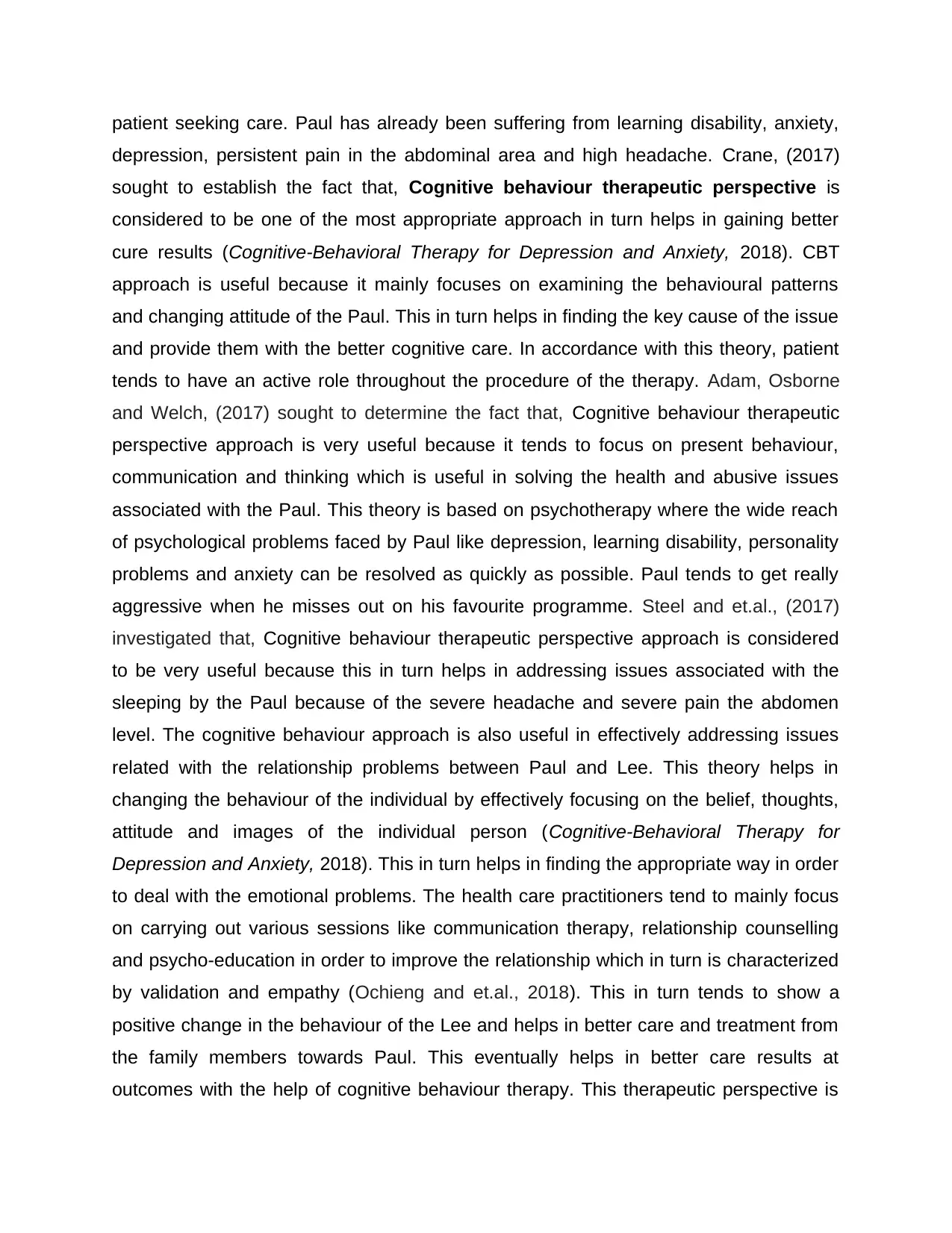
patient seeking care. Paul has already been suffering from learning disability, anxiety,
depression, persistent pain in the abdominal area and high headache. Crane, (2017)
sought to establish the fact that, Cognitive behaviour therapeutic perspective is
considered to be one of the most appropriate approach in turn helps in gaining better
cure results (Cognitive-Behavioral Therapy for Depression and Anxiety, 2018). CBT
approach is useful because it mainly focuses on examining the behavioural patterns
and changing attitude of the Paul. This in turn helps in finding the key cause of the issue
and provide them with the better cognitive care. In accordance with this theory, patient
tends to have an active role throughout the procedure of the therapy. Adam, Osborne
and Welch, (2017) sought to determine the fact that, Cognitive behaviour therapeutic
perspective approach is very useful because it tends to focus on present behaviour,
communication and thinking which is useful in solving the health and abusive issues
associated with the Paul. This theory is based on psychotherapy where the wide reach
of psychological problems faced by Paul like depression, learning disability, personality
problems and anxiety can be resolved as quickly as possible. Paul tends to get really
aggressive when he misses out on his favourite programme. Steel and et.al., (2017)
investigated that, Cognitive behaviour therapeutic perspective approach is considered
to be very useful because this in turn helps in addressing issues associated with the
sleeping by the Paul because of the severe headache and severe pain the abdomen
level. The cognitive behaviour approach is also useful in effectively addressing issues
related with the relationship problems between Paul and Lee. This theory helps in
changing the behaviour of the individual by effectively focusing on the belief, thoughts,
attitude and images of the individual person (Cognitive-Behavioral Therapy for
Depression and Anxiety, 2018). This in turn helps in finding the appropriate way in order
to deal with the emotional problems. The health care practitioners tend to mainly focus
on carrying out various sessions like communication therapy, relationship counselling
and psycho-education in order to improve the relationship which in turn is characterized
by validation and empathy (Ochieng and et.al., 2018). This in turn tends to show a
positive change in the behaviour of the Lee and helps in better care and treatment from
the family members towards Paul. This eventually helps in better care results at
outcomes with the help of cognitive behaviour therapy. This therapeutic perspective is
depression, persistent pain in the abdominal area and high headache. Crane, (2017)
sought to establish the fact that, Cognitive behaviour therapeutic perspective is
considered to be one of the most appropriate approach in turn helps in gaining better
cure results (Cognitive-Behavioral Therapy for Depression and Anxiety, 2018). CBT
approach is useful because it mainly focuses on examining the behavioural patterns
and changing attitude of the Paul. This in turn helps in finding the key cause of the issue
and provide them with the better cognitive care. In accordance with this theory, patient
tends to have an active role throughout the procedure of the therapy. Adam, Osborne
and Welch, (2017) sought to determine the fact that, Cognitive behaviour therapeutic
perspective approach is very useful because it tends to focus on present behaviour,
communication and thinking which is useful in solving the health and abusive issues
associated with the Paul. This theory is based on psychotherapy where the wide reach
of psychological problems faced by Paul like depression, learning disability, personality
problems and anxiety can be resolved as quickly as possible. Paul tends to get really
aggressive when he misses out on his favourite programme. Steel and et.al., (2017)
investigated that, Cognitive behaviour therapeutic perspective approach is considered
to be very useful because this in turn helps in addressing issues associated with the
sleeping by the Paul because of the severe headache and severe pain the abdomen
level. The cognitive behaviour approach is also useful in effectively addressing issues
related with the relationship problems between Paul and Lee. This theory helps in
changing the behaviour of the individual by effectively focusing on the belief, thoughts,
attitude and images of the individual person (Cognitive-Behavioral Therapy for
Depression and Anxiety, 2018). This in turn helps in finding the appropriate way in order
to deal with the emotional problems. The health care practitioners tend to mainly focus
on carrying out various sessions like communication therapy, relationship counselling
and psycho-education in order to improve the relationship which in turn is characterized
by validation and empathy (Ochieng and et.al., 2018). This in turn tends to show a
positive change in the behaviour of the Lee and helps in better care and treatment from
the family members towards Paul. This eventually helps in better care results at
outcomes with the help of cognitive behaviour therapy. This therapeutic perspective is
⊘ This is a preview!⊘
Do you want full access?
Subscribe today to unlock all pages.

Trusted by 1+ million students worldwide
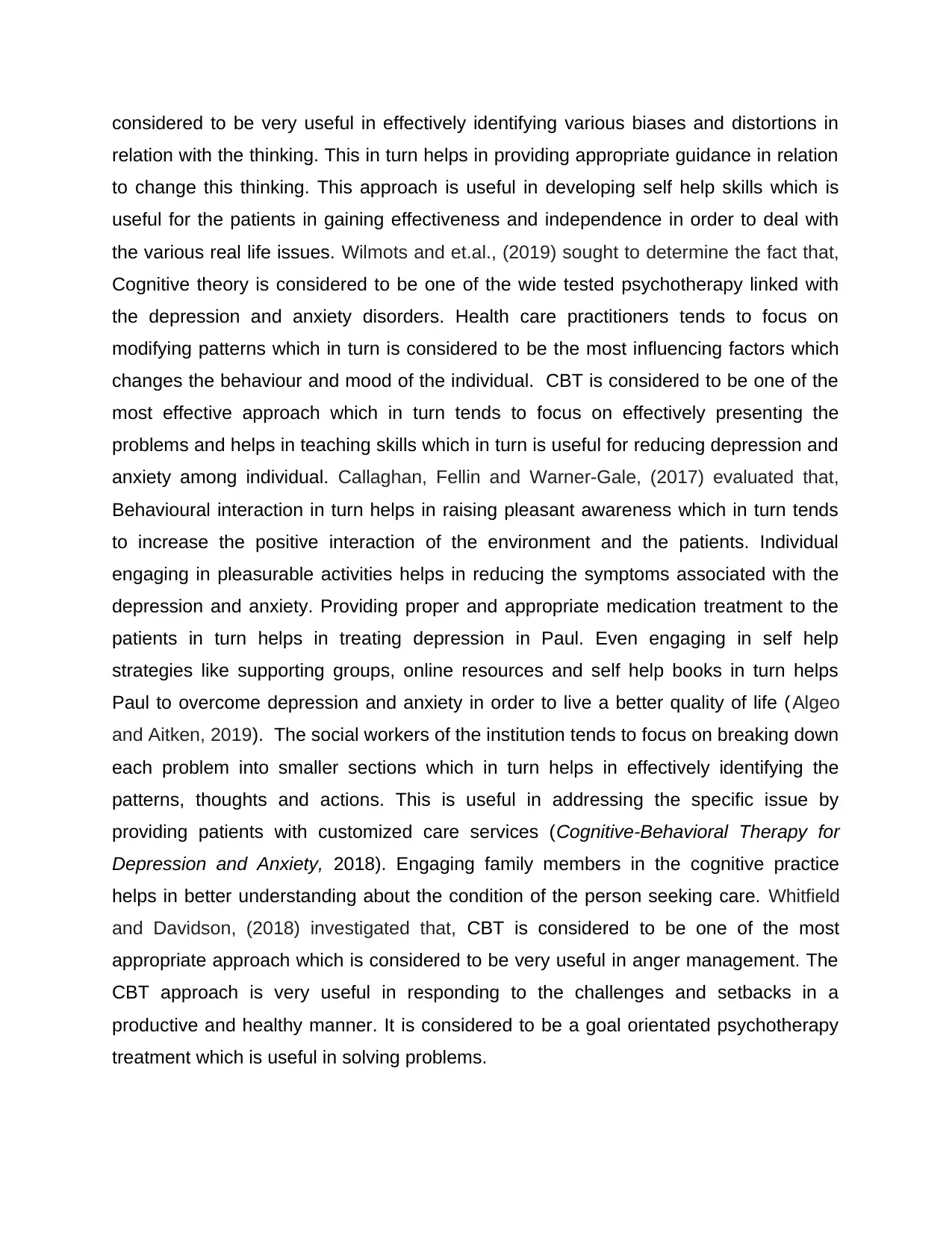
considered to be very useful in effectively identifying various biases and distortions in
relation with the thinking. This in turn helps in providing appropriate guidance in relation
to change this thinking. This approach is useful in developing self help skills which is
useful for the patients in gaining effectiveness and independence in order to deal with
the various real life issues. Wilmots and et.al., (2019) sought to determine the fact that,
Cognitive theory is considered to be one of the wide tested psychotherapy linked with
the depression and anxiety disorders. Health care practitioners tends to focus on
modifying patterns which in turn is considered to be the most influencing factors which
changes the behaviour and mood of the individual. CBT is considered to be one of the
most effective approach which in turn tends to focus on effectively presenting the
problems and helps in teaching skills which in turn is useful for reducing depression and
anxiety among individual. Callaghan, Fellin and Warner-Gale, (2017) evaluated that,
Behavioural interaction in turn helps in raising pleasant awareness which in turn tends
to increase the positive interaction of the environment and the patients. Individual
engaging in pleasurable activities helps in reducing the symptoms associated with the
depression and anxiety. Providing proper and appropriate medication treatment to the
patients in turn helps in treating depression in Paul. Even engaging in self help
strategies like supporting groups, online resources and self help books in turn helps
Paul to overcome depression and anxiety in order to live a better quality of life ( Algeo
and Aitken, 2019). The social workers of the institution tends to focus on breaking down
each problem into smaller sections which in turn helps in effectively identifying the
patterns, thoughts and actions. This is useful in addressing the specific issue by
providing patients with customized care services (Cognitive-Behavioral Therapy for
Depression and Anxiety, 2018). Engaging family members in the cognitive practice
helps in better understanding about the condition of the person seeking care. Whitfield
and Davidson, (2018) investigated that, CBT is considered to be one of the most
appropriate approach which is considered to be very useful in anger management. The
CBT approach is very useful in responding to the challenges and setbacks in a
productive and healthy manner. It is considered to be a goal orientated psychotherapy
treatment which is useful in solving problems.
relation with the thinking. This in turn helps in providing appropriate guidance in relation
to change this thinking. This approach is useful in developing self help skills which is
useful for the patients in gaining effectiveness and independence in order to deal with
the various real life issues. Wilmots and et.al., (2019) sought to determine the fact that,
Cognitive theory is considered to be one of the wide tested psychotherapy linked with
the depression and anxiety disorders. Health care practitioners tends to focus on
modifying patterns which in turn is considered to be the most influencing factors which
changes the behaviour and mood of the individual. CBT is considered to be one of the
most effective approach which in turn tends to focus on effectively presenting the
problems and helps in teaching skills which in turn is useful for reducing depression and
anxiety among individual. Callaghan, Fellin and Warner-Gale, (2017) evaluated that,
Behavioural interaction in turn helps in raising pleasant awareness which in turn tends
to increase the positive interaction of the environment and the patients. Individual
engaging in pleasurable activities helps in reducing the symptoms associated with the
depression and anxiety. Providing proper and appropriate medication treatment to the
patients in turn helps in treating depression in Paul. Even engaging in self help
strategies like supporting groups, online resources and self help books in turn helps
Paul to overcome depression and anxiety in order to live a better quality of life ( Algeo
and Aitken, 2019). The social workers of the institution tends to focus on breaking down
each problem into smaller sections which in turn helps in effectively identifying the
patterns, thoughts and actions. This is useful in addressing the specific issue by
providing patients with customized care services (Cognitive-Behavioral Therapy for
Depression and Anxiety, 2018). Engaging family members in the cognitive practice
helps in better understanding about the condition of the person seeking care. Whitfield
and Davidson, (2018) investigated that, CBT is considered to be one of the most
appropriate approach which is considered to be very useful in anger management. The
CBT approach is very useful in responding to the challenges and setbacks in a
productive and healthy manner. It is considered to be a goal orientated psychotherapy
treatment which is useful in solving problems.
Paraphrase This Document
Need a fresh take? Get an instant paraphrase of this document with our AI Paraphraser
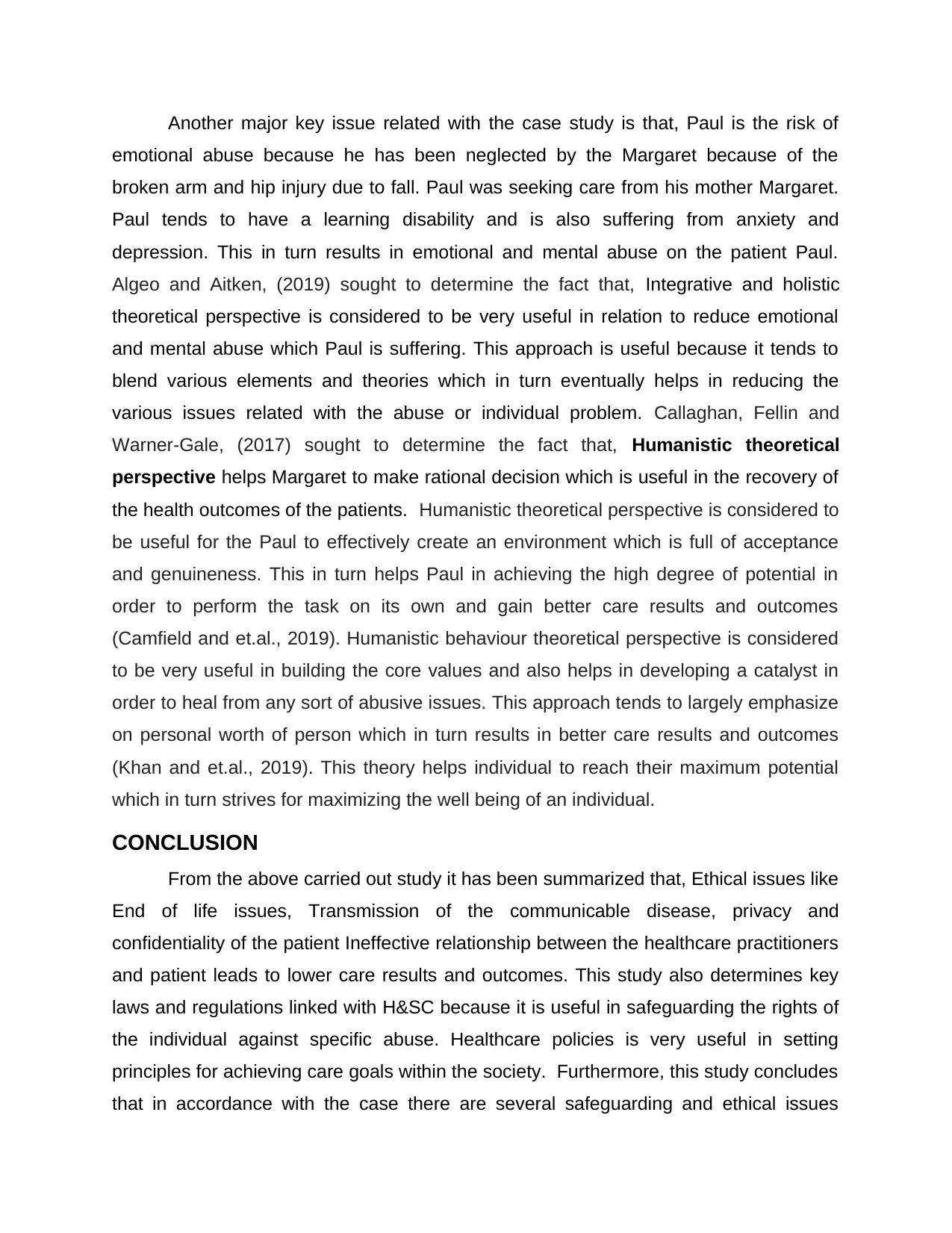
Another major key issue related with the case study is that, Paul is the risk of
emotional abuse because he has been neglected by the Margaret because of the
broken arm and hip injury due to fall. Paul was seeking care from his mother Margaret.
Paul tends to have a learning disability and is also suffering from anxiety and
depression. This in turn results in emotional and mental abuse on the patient Paul.
Algeo and Aitken, (2019) sought to determine the fact that, Integrative and holistic
theoretical perspective is considered to be very useful in relation to reduce emotional
and mental abuse which Paul is suffering. This approach is useful because it tends to
blend various elements and theories which in turn eventually helps in reducing the
various issues related with the abuse or individual problem. Callaghan, Fellin and
Warner-Gale, (2017) sought to determine the fact that, Humanistic theoretical
perspective helps Margaret to make rational decision which is useful in the recovery of
the health outcomes of the patients. Humanistic theoretical perspective is considered to
be useful for the Paul to effectively create an environment which is full of acceptance
and genuineness. This in turn helps Paul in achieving the high degree of potential in
order to perform the task on its own and gain better care results and outcomes
(Camfield and et.al., 2019). Humanistic behaviour theoretical perspective is considered
to be very useful in building the core values and also helps in developing a catalyst in
order to heal from any sort of abusive issues. This approach tends to largely emphasize
on personal worth of person which in turn results in better care results and outcomes
(Khan and et.al., 2019). This theory helps individual to reach their maximum potential
which in turn strives for maximizing the well being of an individual.
CONCLUSION
From the above carried out study it has been summarized that, Ethical issues like
End of life issues, Transmission of the communicable disease, privacy and
confidentiality of the patient Ineffective relationship between the healthcare practitioners
and patient leads to lower care results and outcomes. This study also determines key
laws and regulations linked with H&SC because it is useful in safeguarding the rights of
the individual against specific abuse. Healthcare policies is very useful in setting
principles for achieving care goals within the society. Furthermore, this study concludes
that in accordance with the case there are several safeguarding and ethical issues
emotional abuse because he has been neglected by the Margaret because of the
broken arm and hip injury due to fall. Paul was seeking care from his mother Margaret.
Paul tends to have a learning disability and is also suffering from anxiety and
depression. This in turn results in emotional and mental abuse on the patient Paul.
Algeo and Aitken, (2019) sought to determine the fact that, Integrative and holistic
theoretical perspective is considered to be very useful in relation to reduce emotional
and mental abuse which Paul is suffering. This approach is useful because it tends to
blend various elements and theories which in turn eventually helps in reducing the
various issues related with the abuse or individual problem. Callaghan, Fellin and
Warner-Gale, (2017) sought to determine the fact that, Humanistic theoretical
perspective helps Margaret to make rational decision which is useful in the recovery of
the health outcomes of the patients. Humanistic theoretical perspective is considered to
be useful for the Paul to effectively create an environment which is full of acceptance
and genuineness. This in turn helps Paul in achieving the high degree of potential in
order to perform the task on its own and gain better care results and outcomes
(Camfield and et.al., 2019). Humanistic behaviour theoretical perspective is considered
to be very useful in building the core values and also helps in developing a catalyst in
order to heal from any sort of abusive issues. This approach tends to largely emphasize
on personal worth of person which in turn results in better care results and outcomes
(Khan and et.al., 2019). This theory helps individual to reach their maximum potential
which in turn strives for maximizing the well being of an individual.
CONCLUSION
From the above carried out study it has been summarized that, Ethical issues like
End of life issues, Transmission of the communicable disease, privacy and
confidentiality of the patient Ineffective relationship between the healthcare practitioners
and patient leads to lower care results and outcomes. This study also determines key
laws and regulations linked with H&SC because it is useful in safeguarding the rights of
the individual against specific abuse. Healthcare policies is very useful in setting
principles for achieving care goals within the society. Furthermore, this study concludes
that in accordance with the case there are several safeguarding and ethical issues

which can be resolved through theoretical perspective approach like Patient centred
care theory, Adult learning theories, Humanistic behaviour theoretical perspective,
Cognitive behaviour therapeutic perspective, conflict approach, Integrative and holistic
theoretical perspective in H&SC.
care theory, Adult learning theories, Humanistic behaviour theoretical perspective,
Cognitive behaviour therapeutic perspective, conflict approach, Integrative and holistic
theoretical perspective in H&SC.
⊘ This is a preview!⊘
Do you want full access?
Subscribe today to unlock all pages.

Trusted by 1+ million students worldwide
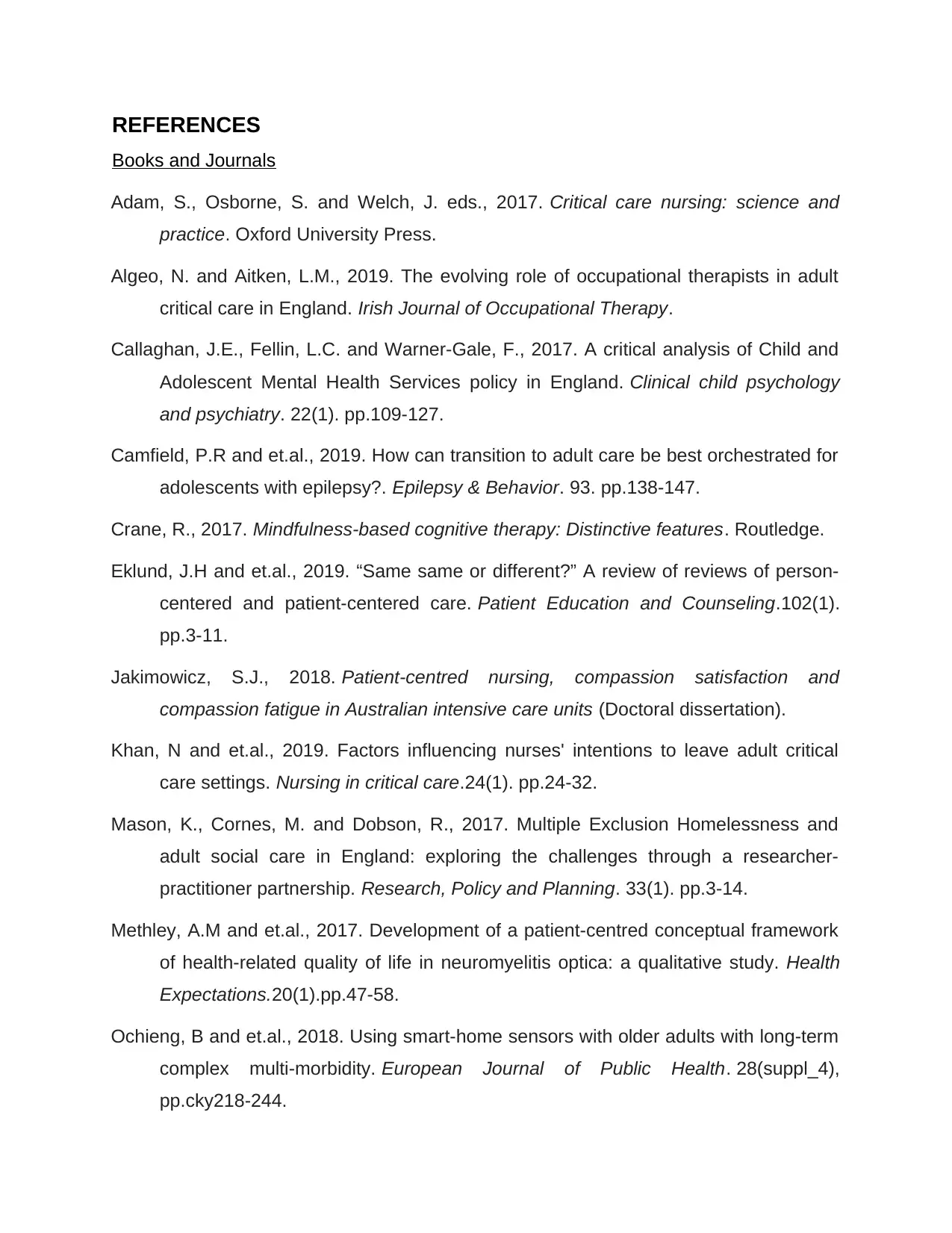
REFERENCES
Books and Journals
Adam, S., Osborne, S. and Welch, J. eds., 2017. Critical care nursing: science and
practice. Oxford University Press.
Algeo, N. and Aitken, L.M., 2019. The evolving role of occupational therapists in adult
critical care in England. Irish Journal of Occupational Therapy.
Callaghan, J.E., Fellin, L.C. and Warner-Gale, F., 2017. A critical analysis of Child and
Adolescent Mental Health Services policy in England. Clinical child psychology
and psychiatry. 22(1). pp.109-127.
Camfield, P.R and et.al., 2019. How can transition to adult care be best orchestrated for
adolescents with epilepsy?. Epilepsy & Behavior. 93. pp.138-147.
Crane, R., 2017. Mindfulness-based cognitive therapy: Distinctive features. Routledge.
Eklund, J.H and et.al., 2019. “Same same or different?” A review of reviews of person-
centered and patient-centered care. Patient Education and Counseling.102(1).
pp.3-11.
Jakimowicz, S.J., 2018. Patient-centred nursing, compassion satisfaction and
compassion fatigue in Australian intensive care units (Doctoral dissertation).
Khan, N and et.al., 2019. Factors influencing nurses' intentions to leave adult critical
care settings. Nursing in critical care.24(1). pp.24-32.
Mason, K., Cornes, M. and Dobson, R., 2017. Multiple Exclusion Homelessness and
adult social care in England: exploring the challenges through a researcher-
practitioner partnership. Research, Policy and Planning. 33(1). pp.3-14.
Methley, A.M and et.al., 2017. Development of a patient‐centred conceptual framework
of health‐related quality of life in neuromyelitis optica: a qualitative study. Health
Expectations.20(1).pp.47-58.
Ochieng, B and et.al., 2018. Using smart-home sensors with older adults with long-term
complex multi-morbidity. European Journal of Public Health. 28(suppl_4),
pp.cky218-244.
Books and Journals
Adam, S., Osborne, S. and Welch, J. eds., 2017. Critical care nursing: science and
practice. Oxford University Press.
Algeo, N. and Aitken, L.M., 2019. The evolving role of occupational therapists in adult
critical care in England. Irish Journal of Occupational Therapy.
Callaghan, J.E., Fellin, L.C. and Warner-Gale, F., 2017. A critical analysis of Child and
Adolescent Mental Health Services policy in England. Clinical child psychology
and psychiatry. 22(1). pp.109-127.
Camfield, P.R and et.al., 2019. How can transition to adult care be best orchestrated for
adolescents with epilepsy?. Epilepsy & Behavior. 93. pp.138-147.
Crane, R., 2017. Mindfulness-based cognitive therapy: Distinctive features. Routledge.
Eklund, J.H and et.al., 2019. “Same same or different?” A review of reviews of person-
centered and patient-centered care. Patient Education and Counseling.102(1).
pp.3-11.
Jakimowicz, S.J., 2018. Patient-centred nursing, compassion satisfaction and
compassion fatigue in Australian intensive care units (Doctoral dissertation).
Khan, N and et.al., 2019. Factors influencing nurses' intentions to leave adult critical
care settings. Nursing in critical care.24(1). pp.24-32.
Mason, K., Cornes, M. and Dobson, R., 2017. Multiple Exclusion Homelessness and
adult social care in England: exploring the challenges through a researcher-
practitioner partnership. Research, Policy and Planning. 33(1). pp.3-14.
Methley, A.M and et.al., 2017. Development of a patient‐centred conceptual framework
of health‐related quality of life in neuromyelitis optica: a qualitative study. Health
Expectations.20(1).pp.47-58.
Ochieng, B and et.al., 2018. Using smart-home sensors with older adults with long-term
complex multi-morbidity. European Journal of Public Health. 28(suppl_4),
pp.cky218-244.
Paraphrase This Document
Need a fresh take? Get an instant paraphrase of this document with our AI Paraphraser
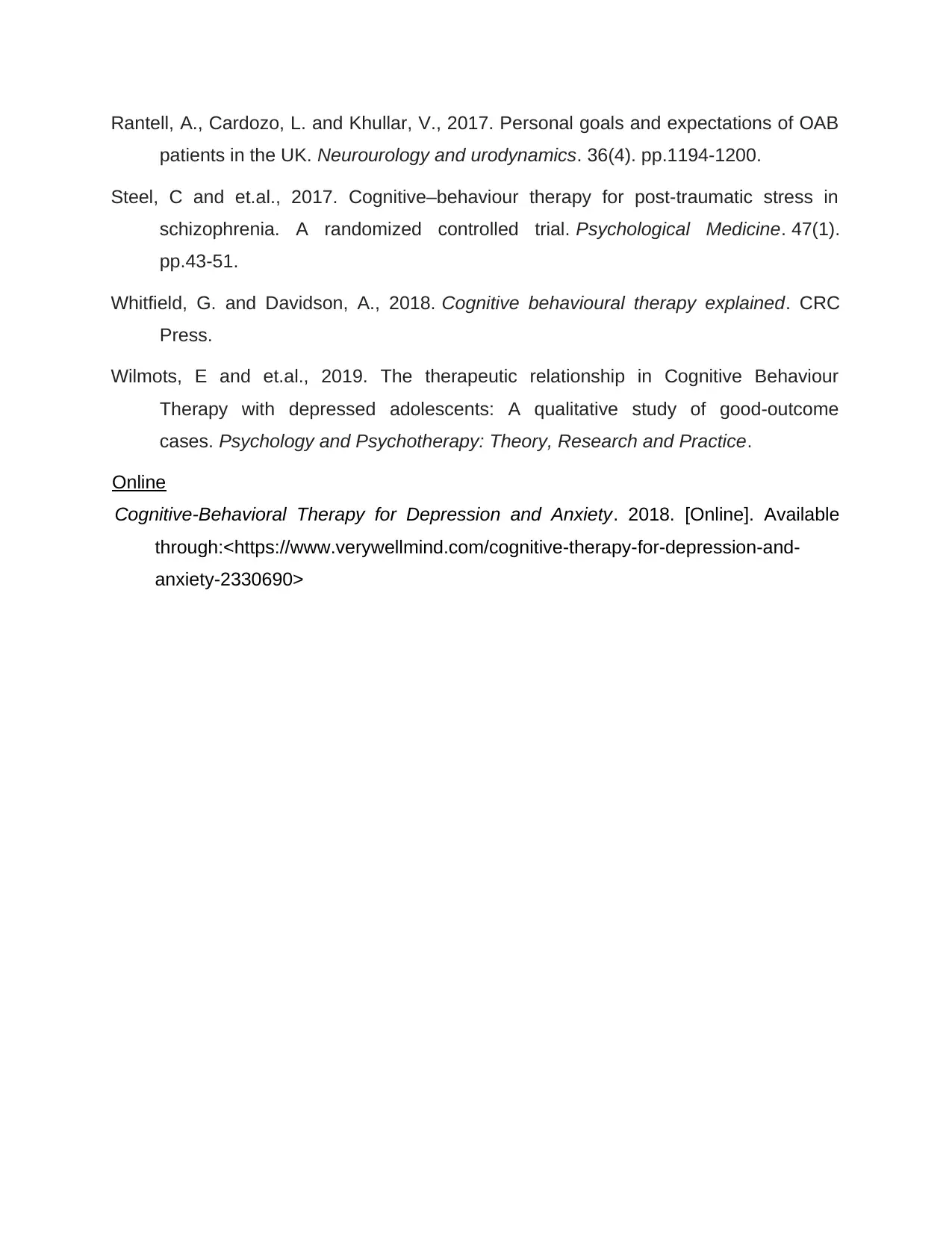
Rantell, A., Cardozo, L. and Khullar, V., 2017. Personal goals and expectations of OAB
patients in the UK. Neurourology and urodynamics. 36(4). pp.1194-1200.
Steel, C and et.al., 2017. Cognitive–behaviour therapy for post-traumatic stress in
schizophrenia. A randomized controlled trial. Psychological Medicine. 47(1).
pp.43-51.
Whitfield, G. and Davidson, A., 2018. Cognitive behavioural therapy explained. CRC
Press.
Wilmots, E and et.al., 2019. The therapeutic relationship in Cognitive Behaviour
Therapy with depressed adolescents: A qualitative study of good‐outcome
cases. Psychology and Psychotherapy: Theory, Research and Practice.
Online
Cognitive-Behavioral Therapy for Depression and Anxiety. 2018. [Online]. Available
through:<https://www.verywellmind.com/cognitive-therapy-for-depression-and-
anxiety-2330690>
patients in the UK. Neurourology and urodynamics. 36(4). pp.1194-1200.
Steel, C and et.al., 2017. Cognitive–behaviour therapy for post-traumatic stress in
schizophrenia. A randomized controlled trial. Psychological Medicine. 47(1).
pp.43-51.
Whitfield, G. and Davidson, A., 2018. Cognitive behavioural therapy explained. CRC
Press.
Wilmots, E and et.al., 2019. The therapeutic relationship in Cognitive Behaviour
Therapy with depressed adolescents: A qualitative study of good‐outcome
cases. Psychology and Psychotherapy: Theory, Research and Practice.
Online
Cognitive-Behavioral Therapy for Depression and Anxiety. 2018. [Online]. Available
through:<https://www.verywellmind.com/cognitive-therapy-for-depression-and-
anxiety-2330690>
1 out of 11
Your All-in-One AI-Powered Toolkit for Academic Success.
+13062052269
info@desklib.com
Available 24*7 on WhatsApp / Email
![[object Object]](/_next/static/media/star-bottom.7253800d.svg)
Unlock your academic potential
Copyright © 2020–2025 A2Z Services. All Rights Reserved. Developed and managed by ZUCOL.
